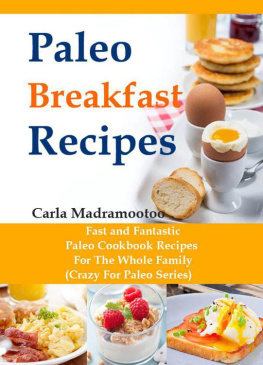Wow! What a wonderful surprise to hear that Nell Stephenson, mycoauthor along with my wife, Lorrie, on The Paleo DietCookbook [John Wiley & Sons (2010)], has decided to individuallyauthor this minibook of quick and easy breakfast recipes. Nell has been involved inthe Paleo Diet movement since it first went viral worldwide. At that time shecontacted me and reported how Paleo had vastly improved her life, health andwell-being and how it had enhanced her performance in triathlons and enduranceevents.
Since then, Nell has become a wonderful spokesperson for the PaleoDiet movement and is recognized worldwide for how this longtime program of eatingcan prove therapeutic for females of all ages, including couch potatoes, casualexercisers and world-class athletes. In addition to coauthoring The Paleo Diet Cookbook , she has solely authored Paleoista , a fascinating and important takeon the Paleo Diet for all people, but particularly for women.
If you want real, unadulterated Paleo recipes, look no further.Nell has nailed it with these fifty recipes. All are pure Paleo. You wont findnon-Paleo ingredients (salt, sea salt, honey, date sugar, coconut sugar, molasses,legumes, dairy products, kefir, beans etc.) here. Nells fifty recipes are quick,easy and delicious.
Breakfast: the most important meal of the day, right? Then how comeso many of us have it all wrong? Most of us at least get the basics; its prettyobvious that a bowl of sugary cereal marketed to kids isnt the best option to eatfirst thing in the morning, or anytime for that matter. But its easy to make themistake of choosing something we think of as being healthy in comparison, such as ahearty bowl of good old-fashioned oatmeal. If we take a closer look, however, itbecomes clear why we may need to reconsider our choices.
A stick-to-the-ribs breakfast of such tried and true grains, alongwith some skim milk, is not only a great breakfast option, it will also help lowercholesterol, wont it? Plus, since the milk is a great source of calcium and theoats give us all the fiber we need, its not even worth considering an alternative,is it? And since its got almost no fat, it will be great for those of us who aretrying to shed a few pounds, right?
Not so fast.
Even though oats dont have the refined sugar that a bowl of kidssugary cereal does, there are still several problems with this seemingly healthybreakfast.
The oats, combined with the fat-free milk, still pack a whoppingcarbohydrate bang, which causes the pancreas to release insulin. The insulin thenshuttles a little bit of the carbohydrate into the skeletal muscles and liver to bestored as glycogen, to be used for the next bout of physical activity.
Guess where most if it goes? The body stores it as fat.
Then what?
Blood sugar levels drop and were hungry again.
The brain tells us we need more sugar and so we repeat the processinstead.
Even though it may have seemed you were on a good path with abreakfast that had only about two to three hundred calories, since the source ofthose calories was primarily carbohydrates, rather than a balance of protein, fatand complex carbohydrates from fresh veggies, this blood sugar roller coaster effectwas the result.
As another example, think about a time when you may have eaten abowl of low-fat cereal and organic milk for breakfast. Did you notice that eventhough it might have tasted great and made you feel as though youd initially hadtons of energy, the way you felt shortly after eating that breakfast was exactly theopposite? Sluggish, with low energy and as though you needed a napor another bowlof the same. This is a blood sugar crash in action, and the least ideal way to startyour day.
Even though it may seem like the smart way to break the fast,once we get into this pattern of eating refined carbohydrates, even though they are,in fact, low in calories and fat, it becomes a lot harder to break the cycle,compared to a situation where we started the day off right in the first place.
We know from the work of Dr. Loren Cordain in his book, The Paleo Diet (Wiley & Sons, 2002), thatoats, along with all grains, including those that are gluten-free, have compoundscalled antinutrients, which prevent the body from properly absorbing many vitaminsand minerals, and also contribute to increased intestinal porosity, a conditionknown as leaky gut.
Think of the intestines as a fine mesh barrier. When we eat foodsthat we can digest properly, such as fresh veggies and fruit, wild, natural proteinsand healthy fats, we keep that barrier healthy and intact.
As soon as we add foods that we cannot properly break down, such asgrains, that fine barrier begins to tear and leak.
This then creates a condition whereby large particles includingbacteria, viruses and waste leak out into our gut. We then see inflammation, notjust locally, but throughout the body and then, as it progresses, infection.
















